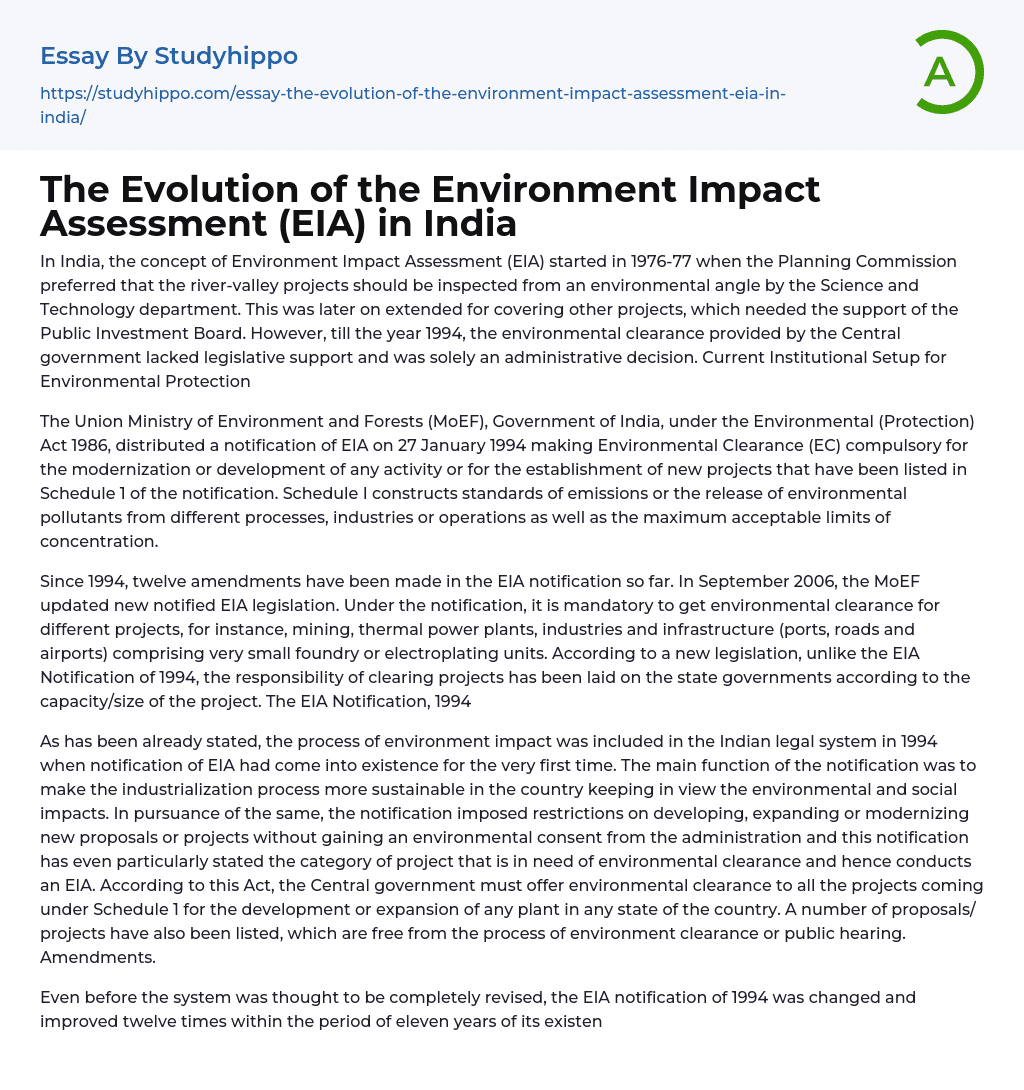

The Evolution of the Environment Impact Assessment (EIA) in India Essay Example
In India, the concept of Environment Impact Assessment (EIA) started in 1976-77 when the Planning Commission preferred that the river-valley projects should be inspected from an environmental angle by the Science and Technology department. This was later on extended for covering other projects, which needed the support of the Public Investment Board. However, till the year 1994, the environmental clearance provided by the Central government lacked legislative support and was solely an administrative decision. Current Institutional Setup for Environmental Protection
The Union Ministry of Environment and Forests (MoEF), Government of India, under the Environmental (Protection) Act 1986, distributed a notification of EIA on 27 January 1994 making Environmental Clearance (EC) compulsory for the modernization or development of any activity or for the establishment of new projects that have been listed in Schedule 1 of the no
...tification. Schedule I constructs standards of emissions or the release of environmental pollutants from different processes, industries or operations as well as the maximum acceptable limits of concentration.
Since 1994, twelve amendments have been made in the EIA notification so far. In September 2006, the MoEF updated new notified EIA legislation. Under the notification, it is mandatory to get environmental clearance for different projects, for instance, mining, thermal power plants, industries and infrastructure (ports, roads and airports) comprising very small foundry or electroplating units. According to a new legislation, unlike the EIA Notification of 1994, the responsibility of clearing projects has been laid on the state governments according to the capacity/size of the project. The EIA Notification, 1994
As has been already stated, the process of environment impact was included in the Indian legal system
in 1994 when notification of EIA had come into existence for the very first time. The main function of the notification was to make the industrialization process more sustainable in the country keeping in view the environmental and social impacts. In pursuance of the same, the notification imposed restrictions on developing, expanding or modernizing new proposals or projects without gaining an environmental consent from the administration and this notification has even particularly stated the category of project that is in need of environmental clearance and hence conducts an EIA. According to this Act, the Central government must offer environmental clearance to all the projects coming under Schedule 1 for the development or expansion of any plant in any state of the country. A number of proposals/ projects have also been listed, which are free from the process of environment clearance or public hearing. Amendments.
Even before the system was thought to be completely revised, the EIA notification of 1994 was changed and improved twelve times within the period of eleven years of its existence, before it was finally revised. Some of the key amendments are given in details below:
- Amendment on 10 April, 1997: the SPCB's (State Pollution Control Board) were assigned to conduct public hearings. They were also given the task of establishing an EPH committee for ensuring impartial representation in the community hearing process. Some changes were made in this amendment, with reference to the compulsory environmental clearance for power plants.
- Amendment on 13 June, 2002: The function of the notification was diluted by the amendment as many industries were exempted from the procedure of EIA or the
entire process of environment clearance in consideration with the level of investment.
of river valley projects, nuclear power projects, thermal power plants, ports, mining projects, harbours and airports, with a lease area consisting of five hectares or more could be attained without any earlier environmental clearance. The EIA Notification, 2006
India as a developing nation is on the way to progress. The rapid increase in urbanization and tremendous increase of development projects are accompanied with significant social and environmental burdens, largely borne by the public residing in the surroundings of the project sites. Therefore, tools of monitoring like the EIA is of great importance in making sure that the economic development is sound enough without compromising on the social and environmental costs.
- Animal Welfare essays
- Zoo essays
- Plastic essays
- Waste Management essays
- Climate Change essays
- Global Warming essays
- Conservation essays
- Recycling essays
- Air Pollution essays
- Carbon Dioxide essays
- Climate essays
- Deforestation essays
- Ecology essays
- Endangered Species essays
- Environmental Issues essays
- Environmental Protection essays
- flood essays
- Greenhouse Gas essays
- Hurricane essays
- Nature essays
- Pollution essays
- Renewable Energy essays
- Sustainability essays
- Tornado essays
- Traffic essays
- Tsunami essays
- Water Pollution essays
- Agriculture essays
- Albert einstein essays
- Animals essays
- Archaeology essays
- Bear essays
- Biology essays
- Birds essays
- Butterfly essays
- Cat essays
- Charles Darwin essays
- Chemistry essays
- Dinosaur essays
- Discovery essays
- Dolphin essays
- Elephant essays
- Eli Whitney essays
- Environmental Science essays
- Evolution essays
- Fish essays
- Genetics essays
- Horse essays
- Human Evolution essays
- Isaac Newton essays



